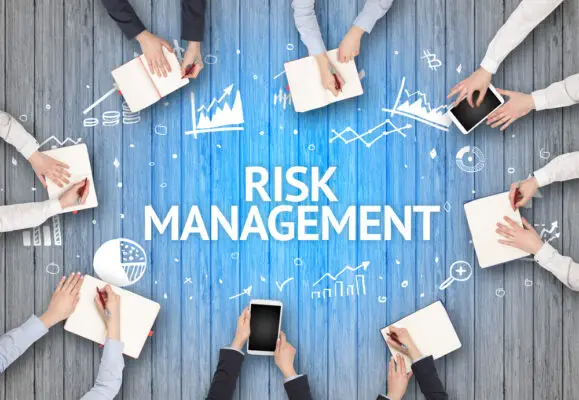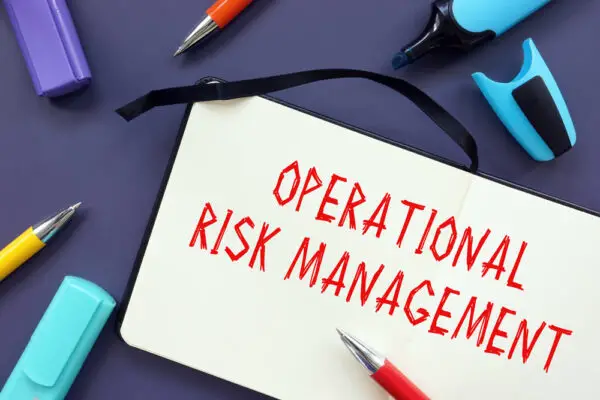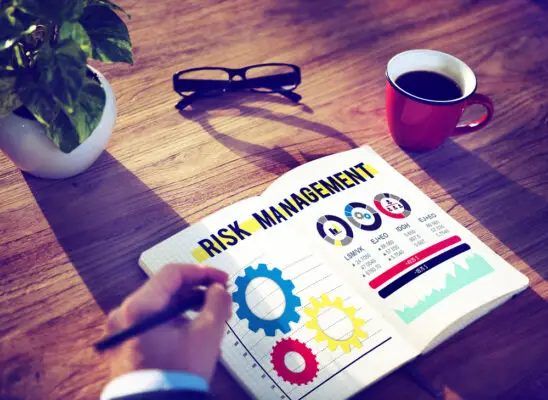Risk management involves anticipating and identifying potential risks to the firm’s operations, assessing their likelihood and impact, and developing strategies for mitigating or exploiting them. Following are some of the values risk management adds to an organization.
Improved Decision-Making: A thorough understanding of potential risks aids decision-making at all levels. Management can make better-informed decisions about strategic and operational issues by quantifying risks.
Cost Reduction: An organization can avoid certain costs and losses by identifying and mitigating risks early. This could include potential fines for non-compliance, costs associated with business disruptions, or reputational damage.
Business Continuity: Risk management is crucial in developing a business continuity plan. By identifying risks to critical operations and processes, the organization can implement plans to ensure that work can continue or recover quickly after a disruption.
Operational Efficiency: By identifying and addressing the root causes of potential risks, risk management can lead to improved processes and operational efficiency.
Stakeholder Confidence: Stakeholders, including investors, employees, customers, and regulators, have greater confidence in an organization that demonstrates a proactive approach to risk management. This can lead to greater investment, higher levels of staff retention, customer loyalty, and positive regulatory relationships.
Competitive Advantage: Organizations that manage risk effectively are more resilient and adaptable, providing a competitive advantage. They are more likely to achieve their strategic objectives, seize new opportunities, and respond effectively to changes in the business environment.
Legal Compliance: Risk management helps ensure an organization identifies and adheres to applicable laws, regulations, and standards, reducing the risk of legal penalties or sanctions.
When implemented effectively, risk management can add significant value to an organisation by improving its performance, enhancing reputation and stakeholder confidence, and ensuring its long-term sustainability.
This article explores how risk management adds value to organisations in different ways. We will examine the key components of effective risk management practices, including risk identification, assessment, mitigation or exploitation strategies development and implementation.
Additionally, we will look at how these practices help firms adapt to changing market conditions while minimizing disruption to business operations.

Identifying Potential Risks and Opportunities
Identifying potential risks and opportunities allows an organization to proactively address potential threats and capitalize on potential benefits, contributing to the overall success and sustainability of the enterprise.
Risk management challenges can occur due to various factors, such as economic volatility, political instability, natural disasters, cyber-attacks, and emerging technology trends.
By identifying these risks early on, organizations can take appropriate measures to mitigate their impact, reducing the likelihood of financial losses or reputational damage.
Risk management benefits extend beyond just protecting against potential harms; it also enables organizations to identify new growth opportunities. For example, companies can adjust their strategies by understanding market-related risks, such as changes in customer preferences or new competitors entering the market.
Moreover, risk management processes can help organizations improve operational efficiency by identifying areas where they may be exposed to unnecessary costs or inefficiencies.
Overall, effective risk management is a crucial component of organizational success. It helps businesses remain competitive in rapidly changing environments while minimizing exposure to potential threats.
Identifying both risks and opportunities through comprehensive risk assessments, companies can make informed decisions that ultimately contribute to their long-term sustainability and growth prospects.
Assessing Likelihood and Impact of Risks
Evaluating the probability and potential impact of identified hazards is essential in risk management. Quantifying risk exposure requires a systematic approach that involves assessing the likelihood and severity of each potential hazard.
This process enables organizations to prioritize their risks effectively, focus on the most significant threats, and allocate resources accordingly.
Organizations must gather data from various sources, such as historical records, industry benchmarks, expert opinions, and statistical analysis to assess the likelihood of a risk occurring.
Once the probability has been established, it is necessary to determine its potential consequences or impact by considering factors such as financial loss, damage to reputation, legal liabilities, operational disruptions or safety hazards.
Prioritizing risk response involves comparing the level of exposure with the organization’s risk appetite and available resources.
Achieving this objective successfully requires clear communication channels across all levels of management so that everyone understands how risks are ranked and what actions should be taken to mitigate them.
Moreover, prioritizing risk response ensures that scarce resources are allocated efficiently to control risks that pose the most significant threat to organizational success.
- Risk management helps reduce uncertainty by providing insights into potential threats.
- Effective risk mitigation strategies can improve stakeholder confidence in an organization’s ability to manage challenges.
- Prioritizing risks allows organizations to optimize resource allocation towards areas where they will have the most significant impact.
- Risk assessment facilitates informed decision-making by providing information on which risks require immediate attention.
- Regular risk review enhances an organisation’s awareness of emerging trends or changing circumstances that may affect future operations.
Assessing both likelihood and impact is crucial for quantifying risk exposure accurately. This process enables organizations to prioritize their responses effectively while optimizing resource allocation towards areas where they will have the most considerable impact.
Doing so regularly while maintaining clear communication channels across all levels within an enterprise can enhance stakeholder confidence in an organization’s ability to manage challenges proactively and reduce uncertainty concerning emerging trends or changing circumstances.
Developing Strategies for Mitigation or Exploitation
Developing effective strategies for risk mitigation or exploitation is a critical component in maximizing organizational success and minimizing potential negative consequences. Proactive planning is essential in identifying risks and developing appropriate measures to mitigate or exploit them.
This process involves evaluating the organization’s strengths, weaknesses, opportunities, and threats (SWOT analysis) to identify areas of vulnerability and determine the best course of action.
One key benefit of proactive risk management is gaining a competitive advantage. Organizations that take a strategic approach to risk management are better positioned to respond quickly to changes in the market or industry trends.
In addition, organizations that successfully manage their risks may be viewed as more reliable by customers, suppliers, investors and other stakeholders. Organizations should adopt an integrated approach that aligns with their overall business objectives to achieve maximum benefits from effective strategies for risk mitigation or exploitation.
This requires engaging all stakeholders across different levels of the organization in developing and implementing risk management policies and procedures. By doing so, organizations can create a culture of awareness and responsibility towards managing risks proactively rather than reactively.
Thus, this will lead to improved performance metrics such as increased revenues, reduced costs and greater stakeholder satisfaction without compromising quality or safety standards.
Enhancing Reputation and Stakeholder Confidence
Enhancing reputation and stakeholder confidence is vital to organizational success, as it can greatly influence the perception of the company’s reliability and credibility, ultimately determining its long-term success or failure.
A strong reputation can attract new customers, retain existing ones, and open doors to new opportunities for growth.
Risk management is essential in enhancing reputation by identifying potential risks that could harm a company’s brand image and developing strategies to mitigate them.
Building trust is a critical component of enhancing reputation. Trust is built when stakeholders believe a company operates with integrity, transparency, and accountability.
Effective risk management practices help companies maintain trust by demonstrating their commitment to ethical business practices, compliance with regulations and laws, and responsible corporate citizenship.
Brand protection is another critical aspect of reputation enhancement. Protecting a brand involves safeguarding against threats such as counterfeiting, intellectual property thefts or infringement issues.
Companies with well-designed risk management programs will be better equipped to identify these threats early on before they cause significant damage to the brand image, in addition to mitigating the impact of these threats through effective crisis communication plans and prompt remediation efforts when necessary.
Effective risk management practices are essential in enhancing an organization’s reputation by building stakeholder trust and protecting its brand from threats.
Adapting to Changing Market Conditions
Adapting to changing market conditions is crucial for organizations seeking long-term success and sustainability in today’s dynamic business environment. Risk management enables companies to respond quickly and effectively to new challenges.
An agile approach that prioritizes risk assessment and mitigation can help businesses identify potential threats early on, allowing them to make proactive decisions that reduce the impact of negative events.
Adopting an agile approach, organizations can turn risks into opportunities and gain a competitive advantage over their peers.
Effective risk management enables companies to pivot quickly in response to shifting market conditions, seize emerging trends, and capitalize on unexpected opportunities.
In conclusion, effective risk management is essential for organizations seeking to adapt successfully to changing market conditions. By adopting an agile approach that prioritizes risk assessment and mitigation, businesses can turn challenges into opportunities and gain a competitive advantage over their peers.
Navigating complex environments requires careful planning, ongoing monitoring, and a willingness to take calculated risks when necessary. Ultimately, those who excel at managing risk will be best positioned for success in today’s rapidly evolving business landscape.

Frequently Asked Questions
How can risk management help an organization in achieving its strategic objectives?
Strategic decision-making is a crucial component of an organization’s success. Risk management plays a significant role in helping organizations achieve their strategic objectives by identifying and mitigating potential risks that may hinder their success.
Risk management benefits include providing insights into the possible outcomes of different decisions and ensuring that the organization takes calculated risks while avoiding blind spots. Furthermore, it assists in creating contingency plans to mitigate the impact of unforeseen events that could derail strategic objectives.
Adopting a structured approach to risk management, organizations can prioritize resources, allocate budgets effectively, and make informed decisions for sustainable growth.
Therefore, incorporating risk management principles into strategic decision-making enables organizations to achieve their goals with minimal disruptions and uncertainties.
What are the key components of an effective risk management framework?
An effective risk management framework comprises key components such as identification, assessment, and mitigation.
Identification involves recognizing potential risks affecting an organization’s operations and objectives.
The assessment follows the identification process, whereby risks are evaluated based on their likelihood of occurrence and potential impact.
Mitigation involves implementing measures to reduce the severity or likelihood of a possible risk occurring.
In addition to these components, fostering a risk culture that promotes awareness and accountability is crucial in maintaining effective risk management practices within an organization.
This can be achieved through regular training sessions and communication channels that facilitate exchanging information about potential risks.
A robust risk management framework ensures that organizations are better equipped to identify and mitigate any potential threats effectively, thereby reducing the likelihood of negative impacts on organizational performance and reputation.
How can an organization ensure that it is taking the right risks and not just avoiding all risks?
In today’s ever-changing business environment, organisations face the challenge of taking risks while ensuring they do not compromise their long-term objectives.
Risk assessment techniques are critical in helping organisations identify and evaluate potential risks to their operations.
However, it is equally important for them to balance risk and reward by adopting a risk appetite framework that aligns with their overall strategy and goals.
In doing so, organisations can ensure that they take the right risks rather than simply avoid all risks altogether.
This approach enables them to seize opportunities in uncertain situations, creating value for stakeholders.
Effective risk management is, therefore, crucial for achieving success in the current business landscape, where uncertainty has become the norm.
What are some challenges in implementing a risk management program in an organization?
Implementing a risk management program in an organization presents several challenges, including communication and implementation. One of the major obstacles is getting buy-in from all stakeholders to embrace the risk management culture.
It requires effective communication strategies that are clear, concise, and understandable to everyone involved.
Additionally, implementing a risk management program involves significant time and effort to properly integrate it into the organizational structure.
This includes identifying potential risks, developing mitigation strategies, establishing protocols for reporting incidents and monitoring the effectiveness of these measures.
Furthermore, ensuring that the program stays relevant and up-to-date requires continuous evaluation and review to identify new risks as they arise.
Overall, successful risk management program implementation requires careful planning, attention to detail, effective communication strategies and ongoing commitment from all stakeholders involved in the process.
How can risk management be integrated into an organization’s day-to-day operations?
A well-planned integration of risk management practices can create a more resilient and adaptable working environment by encouraging employees to think proactively about the risks they face.
It can also promote a culture of accountability where everyone takes responsibility for identifying and managing risks.
Despite its numerous benefits, challenges exist when successfully integrating risk management into daily operations, such as a lack of resources or resistance from employees who may perceive it as an additional burden.
However, proper planning and implementation strategies can overcome these challenges, leading to a safer and more secure business environment that enhances organizational performance in the long run.

Conclusion
Risk management is a crucial aspect of any organization as it helps identify potential risks and opportunities. This process involves assessing the likelihood and impact of these risks, developing strategies to mitigate or exploit them, enhancing reputation and stakeholder confidence, and adapting to changing market conditions.
Risk management adds value to an organization by creating new possibilities for growth.
Another way risk management adds value is by protecting an organization from financial loss. This means they can avoid costly legal battles or reputational damage, which could negatively impact their bottom line.
Effective risk management is critical for any organization seeking sustainable success in today’s competitive business environment. It enables businesses to identify potential risks and opportunities early on and develop appropriate strategies that add value while minimizing loss exposure.

Chris Ekai is a Risk Management expert with over 10 years of experience in the field. He has a Master’s(MSc) degree in Risk Management from University of Portsmouth and is a CPA and Finance professional. He currently works as a Content Manager at Risk Publishing, writing about Enterprise Risk Management, Business Continuity Management and Project Management.

